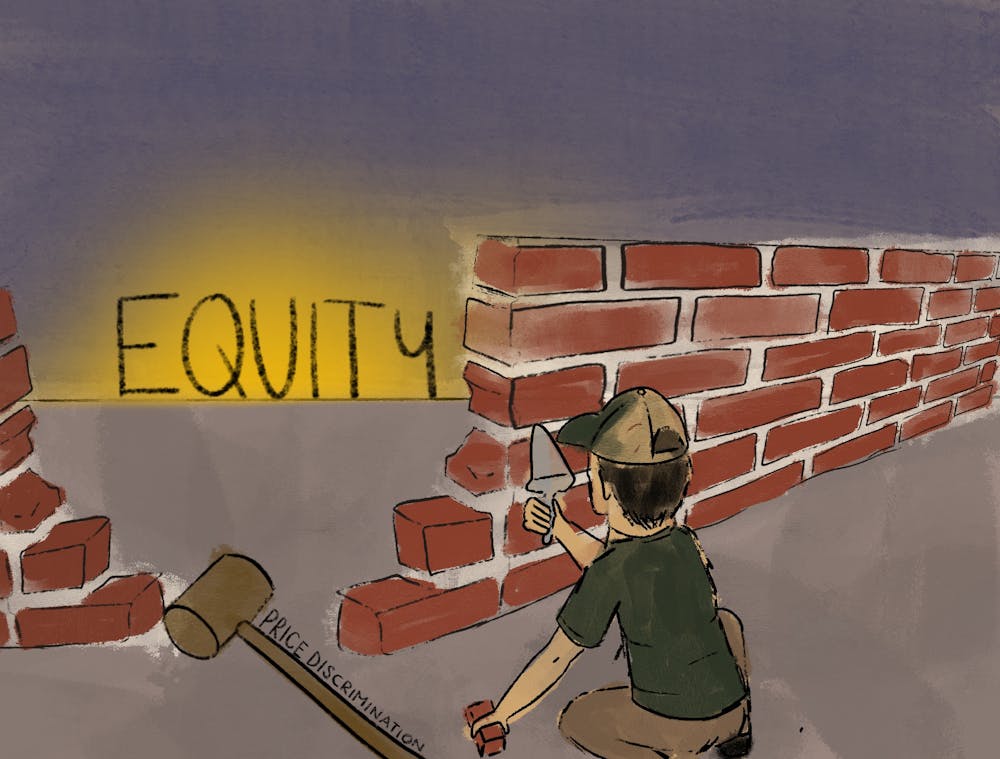It is not often that the concepts we learn in class apply directly to our lives, but price discrimination is a phenomenon college students — particularly out-of-state students — know all too well. Price discrimination is an economic term used to describe how an organization can charge different prices to different customers based on an individual’s willingness to pay. An easy example would be a restaurant that offers a student or senior citizen a discount. By offering a lower price to certain groups, a company increases demand in these groups and, theoretically, both the company and the individuals win.
College students encounter two forms of price discrimination — large discrepancies between in-state and out-of-state tuition and misleading sticker prices. The former constitutes a type of geographic price discrimination while the latter is a sort of socio-economic price discrimination. Ultimately, these schemes have not been beneficial to potential or current students. With the Board of Visitors again raising tuition, it is in our best interest to understand how this system fundamentally fails students. While implemented with good intentions to provide opportunities for everyone, particularly the children of Virginian taxpayers, this two-pronged price discrimination instead contributes to a distinct lack of economic diversity.
The most obvious example of geographic price discrimination at the University is the different costs charged to in-state and out-of-state students. Out-of-staters at the University not only face a sticker price of over twice the price of in-state students but also attend a university whose price is the highest out of all midsize colleges, beating Chapel Hill by over 20,000 dollars. While this difference is egregious, charging out-of-state students higher prices at state universities is the norm. By charging different people different amounts in order to skew in-state demand up and out-of-state down to meet a state-mandated 66 percent in-state student quota, price discrimination at the University is abundantly evident.
The reasoning behind this form of price discrimination lies in a goal to primarily serve the Virginian public who pay taxes that fund the institution. It is entirely valid that one goal of the University should be to aid its state’s community and increase opportunities for low-income residents. Thus, for some, price discrimination seems to be a means to that end. However, the statistics tell us that this ideal of local service is not reality. Consider that 67 percent of the student body comes from families in the 80th percentile of income. If we exaggerate and say all out-of-state students are in this category — one third of the student body — it still means that half of all in-state-students come from families with a large income, the other third. Therefore, even with price discrimination, the University still is not granting opportunities to those in the Virginian community, much less those outside it.
The lesser realized but nonetheless important form of tuition price discrimination is exaggerated sticker prices, the listed cost of tuition. Often, this displayed price tag does not account for tuition aid packages that elite schools like the University give out and which ultimately drive the cost of tuition much lower than advertised. This means that well-off families often pay more tuition than low income families which is price discrimination, albeit well-intentioned. Tuition has been the subject of intense debate in the United States as sticker prices have risen about three times faster than the inflation rate since 1978. However, the real tuition received by universities has hardly changed, meaning increases in sticker prices are offset by increased aid. By setting up a curtain of high prices, the University is able to force high-income students to pay more while offering a more reasonable price to low-income students through financial aid. This is clear price discrimination along socioeconomic lines.
In theory, this system is not negative — the University receives as much money as possible from those who can afford it and creates opportunities for those who cannot. In actuality, redistribution of wealth is not accomplished. Firstly, this system leaves behind middle class families, a large demographic that makes too much money to qualify for most assistance and too little to send their children to an expensive college. Secondly, this system ignores the effect of “sticker shock.” This term describes how low-income students who view the sticker cost as the actual cost prematurely turn away from applying. This, in turn, negates the benefits of price discrimination intended to empower lower income students. This twofold problem results in the same consequences as a geographic price discrimination as many low income out-of-state students fear the high cost and don’t apply. This contributes to a trend in the University’s demographics that inevitably fosters a culture of elitism and exclusion. Essentially, attempting to charge low and high income students different prices has built up barriers to higher education in the very places it proclaimed to break them down.
Eliminating the extreme sticker price system is a great first step to address the problems of sticker shock and out-of-state barriers. This is not a new concept. York College of Pennsylvania tried lowering sticker prices in 2010 by charging less than half what other comparable colleges charged at face value. All students pay the lower cost with less financial aid given out, which may appear unfairly helpful to wealthy families. However, York College was able to encourage many more potential students to apply, enlarging their applicant pool by 300% and enabling a wide diversity of demographics. The University chooses who to accept, and if given the option to admit more low income students, it truly has the power to help its community.
Tuition increases continue to provoke debate on how the University employs price discrimination through tuition. The current uses of price discrimination have been ineffective in reducing the barrier between low-income students and a great education, in actuality they have increased this obstacle. The system needs reworking. By tearing down the veil that is price discrimination, the University will be able to achieve the community support and economic diversity it needs.
Paul Kurtzweil is a senior associate opinion editor who writes about economics, business and housing for The Cavalier Daily. He can be reached at opinion@cavalierdaily.com.
The opinions expressed in this column are not necessarily those of The Cavalier Daily. Columns represent the views of the authors alone.







